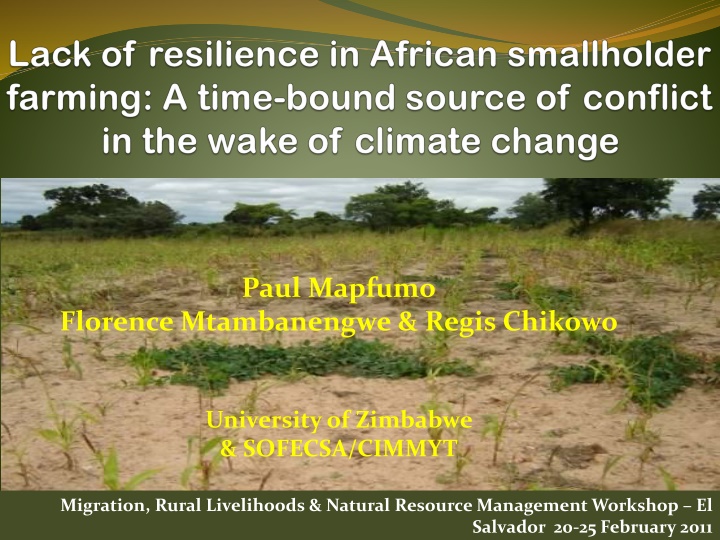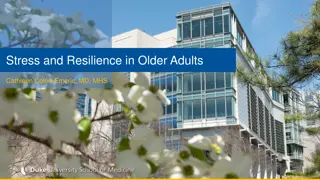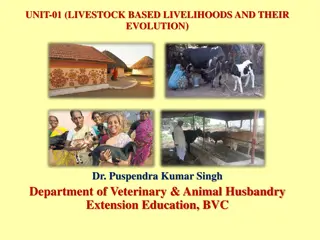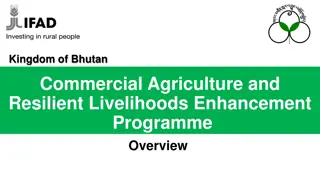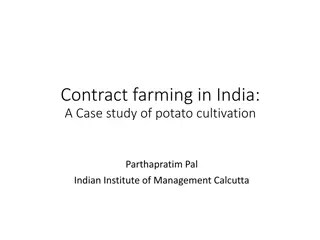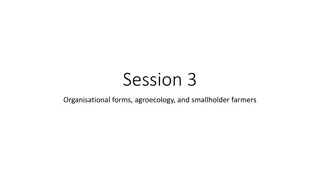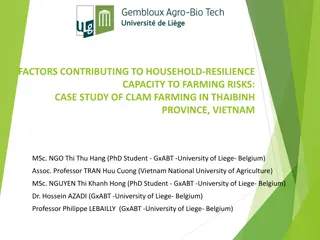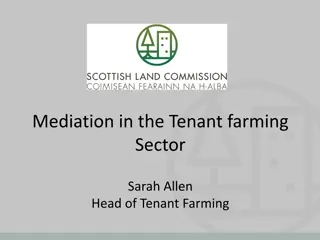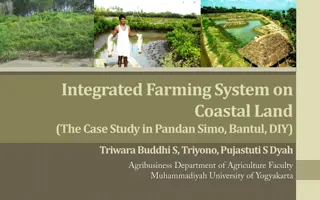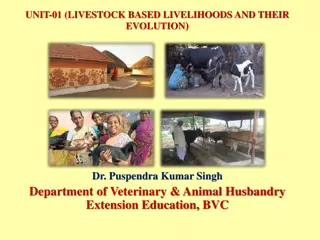Enhancing Resilience in African Smallholder Farming: A Collaborative Approach
The project, led by the University of Zimbabwe in partnership with SOFECSA and the University of Wageningen, aims to address the lack of resilience in African smallholder farming to climate change pressures. Focused on sustainable food security and livelihoods in Southern Africa, initiatives such as integrated soil fertility management and technical innovations are being developed and promoted. The context underscores the entrenched poverty in smallholder farming areas due to historical and environmental factors. Migration is identified as a default objective to escape rural poverty, highlighting the challenges faced by vulnerable groups. Addressing these issues requires capacity building, preservation of indigenous knowledge, and initiatives to enhance adaptive capacity.
Download Presentation

Please find below an Image/Link to download the presentation.
The content on the website is provided AS IS for your information and personal use only. It may not be sold, licensed, or shared on other websites without obtaining consent from the author.If you encounter any issues during the download, it is possible that the publisher has removed the file from their server.
You are allowed to download the files provided on this website for personal or commercial use, subject to the condition that they are used lawfully. All files are the property of their respective owners.
The content on the website is provided AS IS for your information and personal use only. It may not be sold, licensed, or shared on other websites without obtaining consent from the author.
E N D
Presentation Transcript
Paul Mapfumo Florence Mtambanengwe & Regis Chikowo University of Zimbabwe & SOFECSA/CIMMYT Migration, Rural Livelihoods & Natural Resource Management Workshop El University of Zimbabwe Salvador 20-25 February 2011
Who is SOFECSA? Soil Fertility Consortium for Southern Africa (SOFECSA) Multi-institutional, interdisciplinary consortium in 2005 to: Develop and promote technical and institutional innovations that enhance contributions of integrated soil fertility management (ISFM) research and development to sustainable food security and livelihood options in Southern Africa ..With a deliberate focus on improving the capacity of individual scientists and national agricultural research and extension (NAREs) institutions to conduct quality research at different levels in Malawi, Mozambique, Zambia & Zimbabwe Hosted by CIMMYT southern Africa in Harare, Zimbabwe University of Zimbabwe
Reducing Poverty and Food insecurity remains the main Challenge for Sub-Saharan Africa About 180 million Africans live on < US$1 each day Livelihoods mainly based on extensive exploitation of natural resources principally rainfed agriculture, forest and fisheries University of Zimbabwe
The context of poverty in smallholder farming areas of Southern Africa The poverty is entrenched : Legacy of colonial architecture smallholders (natives) not designed to participate in economic activities Environmental marginality limited livelihood opportunities (vulnerable groups often excluded from any emerging economic opportunities mining, irrigation schemes, cash cropping) Loss of dignity and self-respect adopted and endorsed by current institutions (e.g. rural as punishment/icon of backwardness) Loss of own languages and indigenous knowledge (challenge for capacity building) Migration a default objective to escape rural poverty University of Zimbabwe
The Project: Lack of resilience in African smallholder farming: Exploring measures to enhance the adaptive capacity of local communities to pressures of climate change Lead institution: University of Zimbabwe in Collaboration with SOFECSA and University of Wageningen Funding: IDRC-DfID through the Climate Change Adaptation in Africa (CCAA) Program University of Zimbabwe
Project objectives The project sought to work with smallholder farmers in identifying and using improved farming technologies to adapt to climate change and variability same time enhance the capacity of participating institutions and individual researchers to conduct climate change research & development initiatives with communities Mali Ghana and at the Uganda Tanzania Zambia Zimbabwe University of Zimbabwe
Main characteristics of SA farming systems Commercial versus communal Smallholder farming systems are maize-based (80% land to maize year-1), with strong livestock interactions Frequent droughts and market volatility High fertilizer-maize price ratios resulting from policy constraints Declining farm sizes and draught animal ownership Reduced labor supply due to HIV/AIDs Falling migrant remittances (sometimes reversed) Land locked countries versus stringent cross-boarder conditions: little trade and technology exchange Low productivity and high vulnerability encourages risk-averse agricultural strategies at all levels (including slash and burn agriculture), especially among the resource-poor households and in marginal areas University of Zimbabwe
Major challenges for Southern Africa Poor & declining soil fertility: smallholder production systems in Southern Africa are at rock bottom Lack of resilience in the farming systems limited market opportunities and livelihood options Compounding effects of climate change and variability Lack of capacity to deliver agricultural research and development A broken pipe scenario Existence of A maize poverty trap University of Zimbabwe
Empty Soils Empty Stomachs Livelihoods Poor LAND & CONFLICT Rural Poverty Poor & declining soil fertility poor technology adoption Loss of interest to participate No capacity to invest even in low- input technologies Poor market access Unfavourable policies Nutrient leaky systems Low nutrient capital in soils Poor access & availability of nutrient resources Low & inefficient fertilizer use Poor soil fertility: a social, economic and biophysical problem University of Zimbabwe The vicious cycle: A Poverty Trap
The project recognises that: Farming systems in Africa are diverse and heterogeneous One of emerging challenges of climate change and variability is that effects are particularly localised, requiring local solutions There are NO one size fit all or silver bullet technologies Need for participatory action research to generate best-fitting innovations University of Zimbabwe
Methodology Participatory action research Action Action Action Problem Solution Farmer learning centres Participatory modelling Innovation systems approaches University of Zimbabwe
Key findings University of Zimbabwe
Non-Timber Forest Product Consumption in Wedza Zimbabwe NTFP contributed ~20% of energy intake for wealthier farmers And ~40% of energy intake of poorer farmers Often a source of conflict for communities Tsuro Tsubvu Mazhanje Derere Tsenza Matamba Hacha University of Zimbabwe
Smallholders only food secure 4 months in a year in Mozambique Month Food sources (no legumes) January Vegetables, mangoes, cassava leaves February Vegetables, pumpkins, cassava leaves March Green mealies, early maize, pumpkins April Green mealies, early maize, sweet potatoes May Maize, sweet potato, small grain cereals, madhumbe June Maize, cassava, sorghumcereals, madhumbe July Maize, cassava, small grain cereals, madhumbe August Maize, cassava, banana, small grain cereals, madhumbe September Tree roots, honey, mazhanje, October Tree roots, honey November Honey, mangoes December Honey, mangoes, wild fruits, vegetables University of Zimbabwe
Contemplating migration? Major sources of vulnerability Poor soil fertility, poor infrastructure, lack of access to markets climate change & variability breakdown in social safety nets University of Zimbabwe
A degrading natural resource base: Wrong decisions versus difficult choices University of Zimbabwe
Glaring threats! Failure to attain food-self sufficiency at household, community and national levels Diminishing diversity of crop types/varieties & food sources Tailored culture of dependence on aid and relief food sources Undermining of traditional social safety nets General lack of local empirical content in the conceptualisation and design of research and development initiatives General neglect of locally generated knowledge & products in development (in favour of the cut and paste solutions) Migration to unknown/unplanned destinations University of Zimbabwe
Sources of vulnerability & conflict Remittances who leaves first (farm development cycle (education as a driver for bubbling out of poverty) Degrade and survive now (e.g. charcoal) Traditional values, norms and regulations for resource management giving way Collapse of safety nets (power struggles, disintegration of extended family rise of capitalistic tendencies as a shock established (loss of resilience) Declining natural resource base ESAP University of Zimbabwe
African smallholder farmers are still heavily dependant on indigenous climate change indicators in their decision making What to crop types and cultivars to grow and when? How to manage food stocks at household and community levels? How to participate in trade and resource-sharing arrangements How to allocate land resources in the medium to long term How to manage investments in livestock (key source of insurance in most communities) When to trigger local disaster response mechanisms University of Zimbabwe
University of Zimbabwe SOFECSA Learning Centres Exiting the Maize Poverty Trap through Integrated Soil Fertility Management (ISFM) Learning with communities to adapt to climate change and variability University of Zimbabwe
Mobilizing smallholder farmers for collective action to increase productivity and access to markets Employing integrated agricultural research for development (IAR4D) approaches Increasing resilience Enhancing capacity of farmers to adapt to climate change & variability Integrated Soil Fertility Management- ISFM- as an entry point Legume-cereal rotations Cereal/legume intercrops Increased mineral fertilizer use Matching farmer resource endowments Combining organic & mineral fertilizers Appropriate crop types & varieties SOFECSA in Zimbabwe SOFECSA in Zimbabwe Building Innovation Platforms Communities Crop diversification Local leaders Service providers Policy makers Increasing productivity Reaching the vulnerable Introducing The Learning Centre approach Fertilizers a must Communicating through drama & song Innovating with communities Building Capacity Stimulating development Household food security Increasing availability of farm resources input& & output market opportunities Off-farm livelihood opportunities Escaping the maize poverty trap University of Zimbabwe
Experimenting with farmers (a) Tongesai (season 1) (b) Tongesai (season 2) 8000 8000 SC 403 SC 513 SC 635 SC403 SC513 SC635 6000 6000 Managing variability - enhanced precision 4000 4000 Maize grain yields (kg ha-1) 2000 2000 0 0 Early Normal Late Early Normal Late (c) Kagura (season 1) (d) Kagura (season 2) 8000 8000 SC513 SC635 SC709 SC 513 SC 635 SC 709 6000 6000 4000 4000 2000 2000 0 0 Early Normal Late Early Normal Late Planting windows University of Zimbabwe
Empowering farmers to access input resources and participate in markets 6 5 Yield benefits of collective action: timely access to appropriate types of inputs Maize grain yields (t ha-1) 4 3 2 1 0 Participating farmers Non-participating farmers University of Zimbabwe
Enhancing farmers capacity to respond Yield effects of appropriate planting time in response to rainfall University of Zimbabwe
Putting ISFM to work according to farmer circumstances Resource endowed (3 >6 t ha-1) Resource constrained (<1 >2 t ha-1) Intermediate (1.5 >3 t ha-1) University of Zimbabwe
Strengthening local institutions to revitalize traditional social safety nets Success with the Zunde raMambo concept in Nyahava, Makoni district Realization of high yields under ISFM technologies convinced farmers to participate University of Zimbabwe
Adaptation options prioritized by communities? Comprehensive capacity building programs for farmers & their service providers Generate surpluses during favourable seasons to offset future deficits Empower communities and service providers for collective acquisition of inputs and marketing of produce Increasing access to production resources & food by vulnerable groups Equip policy makers with locally relevant evidence-based scientific facts for decision making Support platforms for information & knowledge sharing main pathway for information flow is farmer-farmer University of Zimbabwe
Moving towards production-to-marketing models through innovation platforms External (free) Inputs from: Government NGOs Research Remittances Production Resource Base Natural Processing 1 2 Internal Inputs from: Farmers own seed reserves Direct markets purchases Credit schemes by Govt./NGOs/Agro- Financing institutions Contract farming schemes Packaging Consumption Storage Marketing Institutions & Policies 3 4 University of Zimbabwe
Emerging issues 1. Employing ISFM to increase crop productivity and farmer market participation resolved challenges related to land tenure, social safety nets and competing land uses 2. Climate change impacts differentiated by gender and farmer resource endowment among other factors 3. Capacity building initiatives that build on indigenous knowledge enhance farmer decision making 4. Co-learning with communities leads to joint development of best-fit adaptation options, activating internal for mechanisms adaptation 5. PAR enabled communities and service providers for collectively manage natural resources
Thank You University of Zimbabwe
